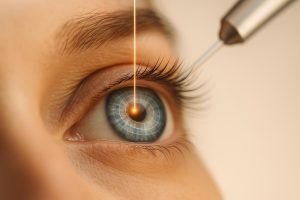LASIK is a laser eye surgery that reshapes the cornea to correct vision issues like nearsightedness, farsightedness, and astigmatism. It’s FDA-approved, safe, and boasts a 96%+ satisfaction rate among patients. Despite its popularity, myths about LASIK persist, such as it being painful, unsafe, or ineffective for astigmatism. Here’s the truth:
- Pain-Free: Numbing drops make the procedure virtually painless, with only minor discomfort during recovery.
- Safe: LASIK has been performed millions of times with a complication rate below 1% – safer than long-term contact lens use.
- Long-Lasting Results: The corneal changes are permanent, though age-related conditions like presbyopia may still occur.
- Treats Astigmatism: Modern technology successfully addresses astigmatism and other vision issues.
- No Risk from Blinking or Moving: Advanced eye-tracking systems ensure precision even with natural eye movements.
If you’re considering LASIK, eligibility depends on factors like age, stable vision, and overall eye health. A professional consultation is essential to determine if it’s the right option for you. LASIK typically costs $2,000–$3,000 per eye but can save money long-term by reducing reliance on glasses or contacts.
10 Myths and Facts of LASIK Eye Surgery
LASIK Myths vs. Facts
Misinformation can hold people back from considering LASIK. Let’s clear up some of the most common myths with facts backed by years of research and experience.
Myth: LASIK Is Painful
The Fact: Thanks to numbing eye drops, LASIK is almost entirely pain-free. Most people describe feeling only mild pressure – similar to pressing gently on a closed eye – during the procedure. After surgery, any discomfort, like slight irritation or dryness, is usually minor and resolves within a few hours or days.
Myth: LASIK Is Unsafe or Risky
The Fact: LASIK has been one of the safest elective surgeries for decades. Approved by the FDA since 1993, it boasts a stellar safety record with over 20 million successful procedures performed in the U.S.. Serious complications are extremely rare, occurring in less than 1% of cases. In fact, the risk of significant vision loss is far lower with LASIK than with long-term contact lens use – patients face a 34 times lower chance of vision loss compared to contacts. Importantly, there are no documented cases of blindness caused by LASIK.
Myth: LASIK Results Do Not Last
The Fact: LASIK permanently reshapes the cornea to correct vision problems like nearsightedness, farsightedness, and astigmatism. However, the procedure doesn’t stop natural aging processes like presbyopia (trouble focusing on close objects) or cataracts. While a small number of patients might need touch-ups over time, most enjoy clear, stable vision for many years without additional procedures.
Myth: LASIK Cannot Treat Astigmatism
The Fact: Modern LASIK technology is highly effective at correcting astigmatism, along with other refractive errors like nearsightedness and farsightedness. Astigmatism, caused by an irregularly shaped cornea, often results in blurry or distorted vision. Advanced lasers can precisely reshape the cornea, addressing these irregularities and often eliminating the need for glasses or contact lenses.
Myth: You Can Blink or Move and Ruin the Procedure
The Fact: Advanced LASIK systems are designed to handle natural eye movements. Sophisticated eye-tracking technology adjusts for even the smallest involuntary movements during surgery. Additionally, a lid speculum keeps your eyelids open, so blinking isn’t an issue. The laser treatment itself is quick – usually under 60 seconds per eye – and normal movements won’t affect the final outcome.
LASIK Safety and Results
Getting a clear picture of LASIK’s safety and long-term outcomes can help you make an informed decision about vision correction. LASIK has a strong track record when it comes to both safety and patient satisfaction.
Safety and Patient Satisfaction
LASIK delivers impressive results, with over 99% of patients achieving better than 20/40 vision – and more than 90% reaching 20/20 or better. It’s no surprise that satisfaction rates for LASIK rank among the highest for elective procedures.
Part of this success comes down to the procedure itself. The recovery is quick, discomfort is minimal, and many patients notice improved vision almost immediately after the quick, 15-minute surgery.
A thorough screening process is another key factor in LASIK’s safety. Before the procedure, surgeons conduct detailed pre-operative evaluations to ensure that candidates are suitable and to identify any potential risk factors. Advanced tracking systems and numbing techniques during surgery further enhance precision and comfort.
When complications do arise, they’re usually minor and temporary. Common issues include mild dry eye or short-term visual disturbances like halos, both of which typically resolve on their own.
Beyond the immediate benefits, LASIK’s long-term reliability adds to its appeal.
How Long LASIK Results Last
LASIK works by permanently reshaping the cornea to correct vision problems like nearsightedness, farsightedness, and astigmatism. This reshaping provides lasting vision improvement.
That said, LASIK doesn’t stop the natural aging process of the eyes. Over time, age-related conditions like presbyopia or cataracts can still affect vision, but these changes are unrelated to the original LASIK correction. Studies spanning 25 years show that most patients maintain their improved vision without needing additional procedures. For the small number of patients who do experience minor regression, enhancement procedures are an option, though they’re rarely needed.
At the Eye Center of Northern Colorado, consultations focus on setting realistic expectations. Their fellowship-trained ophthalmologists explain that while LASIK permanently addresses current refractive errors, regular eye exams are still crucial. These exams help monitor overall eye health and detect any age-related changes early, ensuring that your vision remains as clear as possible for years to come. LASIK may correct your current vision issues, but ongoing care is essential for maintaining overall eye health.
sbb-itb-5ef6ec9
Who Can Get LASIK?
LASIK isn’t for everyone, but for millions of Americans, it’s been a life-changing procedure for clearer vision. Strict eligibility guidelines are in place to ensure both safety and effectiveness. If you’re considering LASIK, understanding these requirements can help you figure out if it’s a good fit for you. Let’s break down the key factors.
LASIK Eligibility Requirements
- Age: You need to be at least 18 years old. While there’s no hard upper age limit, natural changes in the eye – like presbyopia or cataracts – can affect your candidacy and the results you can expect.
- Stable Prescription: Your prescription must remain stable for at least 12 months before surgery. Since LASIK permanently reshapes the cornea, fluctuating prescriptions could lead to less predictable long-term outcomes.
- Corneal Health and Thickness: Adequate corneal thickness is essential. Thin or irregular corneas might require exploring alternative vision correction options.
- Overall Eye and Health Conditions: Good general and eye health is critical. Certain conditions – like keratoconus, severe dry eye, active eye infections, uncontrolled diabetes, autoimmune diseases, or specific medications – can interfere with healing and may rule out LASIK. Additionally, hormonal changes during pregnancy or nursing can affect vision stability, so it’s recommended to wait until after these phases.
For individuals with very high prescriptions or irregular astigmatism, additional evaluations or alternative procedures may be necessary.
Why Professional Consultation Matters
Determining LASIK candidacy isn’t a one-size-fits-all process. A professional consultation with an experienced ophthalmologist or optometrist is essential before making any decisions. During this evaluation, advanced diagnostic tools are used to map your corneal shape and thickness, assess your tear film, and review your full medical and vision history. This detailed assessment helps identify any potential risks that could affect your results.
At the Eye Center of Northern Colorado, fellowship-trained specialists provide personalized LASIK evaluations using cutting-edge diagnostic technology. They’ll evaluate your eye health, prescription stability, and lifestyle to recommend the safest and most effective vision correction plan for you. If LASIK isn’t suitable, they may suggest alternatives like PRK, SMILE, or implantable contact lenses.
The consultation also helps set realistic expectations. For instance, over 99% of LASIK patients achieve better than 20/40 vision, and more than 90% reach 20/20 vision or better. This thorough process ensures you’re fully informed and confident in your decision, while highlighting the proven safety and effectiveness of LASIK as a vision correction option.
Making Informed LASIK Decisions
Understanding LASIK is an important first step when deciding if this procedure aligns with your vision needs. Misinformation – like the belief that LASIK is painful or can’t address astigmatism – often deters eligible candidates from exploring a procedure that could greatly enhance their quality of life. Let’s clear up some common myths with verified facts.
The statistics are compelling: over 40 million LASIK procedures have been performed worldwide, with satisfaction rates exceeding 95% – a testament to its safety and effectiveness. The procedure itself is virtually painless, FDA-approved, and capable of correcting nearsightedness, farsightedness, and astigmatism. Results often last a lifetime, and serious complications are exceedingly rare, with no documented cases of LASIK causing blindness.
However, while these general facts provide a strong foundation, determining if LASIK is right for you requires a personalized evaluation. Not everyone qualifies for the procedure. Factors like age, eye health, corneal thickness, and existing medical conditions need to be carefully assessed. This is why consulting with a professional is essential. Online research can help you understand the basics and debunk myths, but only a qualified eye care professional can assess your candidacy and outline realistic outcomes.
During a comprehensive consultation, advanced diagnostic tools are used to evaluate your corneal shape, thickness, and overall eye health. This thorough process identifies potential risks and helps set realistic expectations tailored to your specific circumstances.
For those in Northern Colorado and Wyoming, the Eye Center of Northern Colorado offers a trusted option. With over 50 years of experience and fellowship-trained specialists, they provide detailed LASIK evaluations using state-of-the-art diagnostic technology. Many patients have praised their approach. For example, in November 2025, Janice White shared her experience, saying her appointment was "one of the most efficient I’ve had in years." She noted how the doctor "took time to introduce himself, carefully checked my test results and didn’t seem to be so rushed". This kind of patient-focused care ensures you receive honest, evidence-based recommendations rather than generic advice.
When choosing a LASIK provider, prioritize professionals who take the time to understand your unique needs, conduct thorough pre-operative assessments, and provide clear, balanced information about both the benefits and limitations. Many reputable centers offer initial consultations at no cost, allowing you to ask questions and explore your options without financial pressure.
The cost of LASIK in the United States typically ranges from $2,000 to $3,000 per eye. While this may seem like a significant upfront expense, it can save money over time by reducing or even eliminating the need for glasses and contact lenses. Ultimately, your decision should reflect your personal circumstances, lifestyle, and comfort with the procedure – not just the price tag.
Making an informed LASIK decision means combining accurate, evidence-based information with personalized guidance from professionals. With the right knowledge and support, you can confidently decide what’s best for your vision needs.
FAQs
Is LASIK more cost-effective than other vision correction methods over time?
While LASIK might feel like a hefty expense upfront, it often turns out to be a smart financial move over time. Think about it – many people spend thousands of dollars throughout their lives on glasses, contact lenses, and all the accompanying supplies. By reducing or even eliminating these ongoing costs, LASIK can actually save you money in the long run.
Beyond the financial aspect, LASIK offers the freedom of clear vision without the hassle of daily upkeep that glasses or contacts require. For many, that convenience alone makes it well worth considering. To find out if LASIK aligns with your vision needs and budget, it’s always a good idea to consult with a trusted provider, like the Eye Center of Northern Colorado. They can help you determine if it’s the right fit for you.
What factors could make someone ineligible for LASIK surgery?
Some factors can rule out LASIK surgery as an option for certain individuals. These include severe dry eye syndrome, very thin or irregular corneas, or an unstable vision prescription that has significantly changed within the past year. In addition, people with specific medical conditions, like autoimmune diseases, or those who are pregnant or nursing, may not qualify for the procedure.
To find out if LASIK is a good fit for you, a thorough eye exam is crucial. At the Eye Center of Northern Colorado, our specialists take the time to evaluate your specific needs and guide you toward the most suitable vision correction solution.
What steps can I take to achieve the best results from LASIK, and how do I choose the right provider?
To get the most out of LASIK surgery, it’s crucial to begin with regular, thorough eye exams. These exams not only ensure your eyes are in good health but also help determine if you’re a suitable candidate for the procedure. Plus, they allow for a precise understanding of your vision needs.
When selecting a LASIK provider, prioritize experience and advanced technology. Specialists with a proven history of success can make all the difference. For instance, the Eye Center of Northern Colorado offers care from fellowship-trained ophthalmologists who combine personalized attention with cutting-edge techniques to deliver outstanding outcomes.





